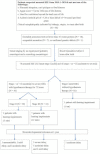Early Biomarkers and Hearing Impairments in Patients with Neonatal Hypoxic-Ischemic Encephalopathy
- PMID: 34829404
- PMCID: PMC8620896
- DOI: 10.3390/diagnostics11112056
Early Biomarkers and Hearing Impairments in Patients with Neonatal Hypoxic-Ischemic Encephalopathy
Abstract
Identifying biomarkers for hearing impairments (HIs) in patients with neonatal hypoxic-ischemic encephalopathy (HIE), to initialize early hearing habilitation, is crucial. Seventy-eight neonates with HIE were divided into the following two groups: those with HIs and those without HIs. We compared those patients with 11,837 newborns without HIE, and analyzed the risk factors of HIs among neonatal HIE. Of the 78 patients, 11 were confirmed to have an HI, which is a substantially higher percentage than in the 11,837 newborns without HIE (14.1% vs. 0.87%; p < 0.001). More patients with moderate-to-severe HIE had confirmed HIs (p = 0.020; odds ratio, 8.61) than those with mild HIE. Clinical staging, and blood lactate and glucose levels could be predictive factors for HIs among patients with HIE. The patients who exhibited HIs had significantly higher lactate (104.8 ± 51.0 vs. 71.4 ± 48.4; U = 181, p = 0.032) and serum glucose (159.5 ± 86.1 vs. 112.1 ± 62.3; U = 166, p = 0.036) levels than those without HIs. A higher prevalence of HIs was noted in the patients with stage III HIE than those with stage II HIE (43.8% vs. 10%; p = 0.008). The degree of HI correlated with brain anomalies and neurodevelopmental outcomes at 1 year of age. Clinical staging, and blood lactate and glucose levels could be predictive factors for HIs among patients with HIE.
Keywords: HIE; biomarker; hearing impairment; neurodevelopment; newborn.
Conflict of interest statement
The authors declare no conflict of interest. The funders had no role in the design of the study; in the collection, analyses, or interpretation of data, in the writing of the manuscript, or in the decision to publish the results.
Figures


Similar articles
-
Identifying Early Diagnostic Biomarkers Associated with Neonatal Hypoxic-Ischemic Encephalopathy.Diagnostics (Basel). 2021 May 18;11(5):897. doi: 10.3390/diagnostics11050897. Diagnostics (Basel). 2021. PMID: 34070031 Free PMC article.
-
Early Blood Glucose Level Post-Admission Correlates with the Outcomes and Oxidative Stress in Neonatal Hypoxic-Ischemic Encephalopathy.Antioxidants (Basel). 2021 Dec 24;11(1):39. doi: 10.3390/antiox11010039. Antioxidants (Basel). 2021. PMID: 35052543 Free PMC article.
-
Troponin I Levels in Neonatal Hypoxic-Ischemic Encephalopathy Are Related to Cardiopulmonary Comorbidity and Neurodevelopmental Outcomes.J Clin Med. 2021 Sep 5;10(17):4010. doi: 10.3390/jcm10174010. J Clin Med. 2021. PMID: 34501458 Free PMC article.
-
Neonatal hypoxic ischemic encephalopathy-related biomarkers in serum and cerebrospinal fluid.Clin Chim Acta. 2015 Oct 23;450:282-97. doi: 10.1016/j.cca.2015.08.021. Epub 2015 Aug 28. Clin Chim Acta. 2015. PMID: 26320853 Review.
-
Biomarkers in neonatal hypoxic-ischemic encephalopathy-Review of the literature to date and future directions for research.Handb Clin Neurol. 2019;162:281-293. doi: 10.1016/B978-0-444-64029-1.00013-8. Handb Clin Neurol. 2019. PMID: 31324315 Review.
Cited by
-
Long-Term Neonatal EEG Modeling with DSP and ML for Grading Hypoxic-Ischemic Encephalopathy Injury.Sensors (Basel). 2025 May 10;25(10):3007. doi: 10.3390/s25103007. Sensors (Basel). 2025. PMID: 40431802 Free PMC article.
-
Prevalence of hearing impairment in neonatal encephalopathy due to hypoxia-ischemia: a systematic review and meta-analysis.Pediatr Res. 2025 Feb;97(3):953-971. doi: 10.1038/s41390-024-03261-w. Epub 2024 May 20. Pediatr Res. 2025. PMID: 38769399 Free PMC article.
References
Grants and funding
LinkOut - more resources
Full Text Sources

